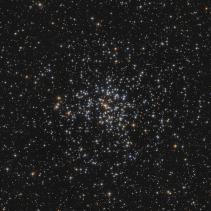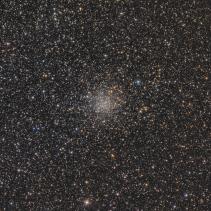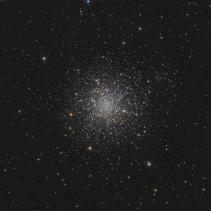Star clusters
M 37
Messier 37 (also known as M37 or NGC 2099) is the richest open cluster in the constellation Auriga. It is the brightest of three open clusters in Auriga and was discovered by the Italian astronomer Giovanni Battista Hodierna before 1654. M37 was missed by French astronomer Guillaume Le Gentil when he rediscovered M36 and M38 in 1749. French astronomer Charles Messier independently rediscovered M37 in September 1764 but all three clusters were recorded by Hodierna.
M37 is located in the antipodal direction, opposite from the Galactic Center as seen from Earth. Estimates of its age range from 347 million to 550 million years. It has 1,500 times the mass of the Sun and contains over 500 identified stars, with roughly 150 stars brighter than magnitude 12.5. M37 has at least a dozen red giants and its hottest surviving main sequence star is of stellar classification B9 V. The abundance of elements other than hydrogen and helium, what astronomers term metallicity, is similar to, if not slightly higher than, the abundance in the Sun.
R = 10 * 600 sec. bin1, G = 10 * 690 sec. bin1, B = 10 * 780 sec. bin1.
PixInsight 1.8, Photoshop CC
M 71
Messier 71 (also known as M71 or NGC 6838) is a globular cluster in the constellation Sagitta. It was discovered by Philippe Loys de Chéseaux in 1745 and included by Charles Messier in his catalog of comet-like objects in 1780. It was also noted by Koehler at Dresden around 1775.
The star cluster is at a distance of about 12,000 light years away from Earth and spans some 27 light years across. The irregular variable star Z Sagittae is a member of this cluster.
R = 11 * 500 sec. bin1, G = 11 * 600 sec. bin1, B = 11 * 700 sec. bin1.
PixInsight 1.8, Photoshop CC
M 12
Messier 12 or M 12 (also designated NGC 6218) is a globular cluster in the constellation of Ophiuchus. It was discovered by the French astronomer Charles Messier on May 30, 1764, who described it as a "nebula without stars".
Located roughly 3° in the sky from the cluster M10 and 5.6° from the star Lambda Ophiuchi, M12 is about 15,700 light-years (4,800 parsecs) from Earth and has a spatial diameter of about 75 light-years. The brightest stars of M12 are of 12th magnitude. With a Shapley-Sawyer rating of IX, it is rather loosely packed for a globular and was once thought to be a tightly concentrated open cluster. Thirteen variable stars have been recorded in this cluster. M12 is approaching us at a velocity of 16 km/s.
R = 11 * 400 sec. bin1, G = 11 * 460 sec. bin1, B = 11 * 560 sec. bin1.
PixInsight 1.8, Photoshop CC
M 5
Messier 5 or M5 (also designated NGC 5904) is a globular cluster in the constellation Serpens.
M5 was discovered by the German astronomer Gottfried Kirch in 1702 when he was observing a comet. Charles Messier also noted it in 1764, but thought it a nebula without any stars associated with it. William Herschel was the first to resolve individual stars in the cluster in 1791, counting roughly 200.
Spanning 165 light-years in diameter, M5 is one of the largest known globular clusters. The gravitational sphere of influence of M5, (i.e. the volume of space in which stars are gravitationally bound to it rather than being torn away by the Milky Way's gravitational pull) has a radius of some 200 light-years.
At 13 billion years old, M5 is also one of the eldest globular clusters in the Milky Way Galaxy. Its distance is about 24,500 light-years from Earth, and it contains more than 100,000 stars, as many as 500,000 according to some estimates.
R = 9 * 600 sec. bin1, G = 9 * 700 sec. bin1, B = 9 * 800 sec. bin1.
PixInsight 1.8, Photoshop CC




